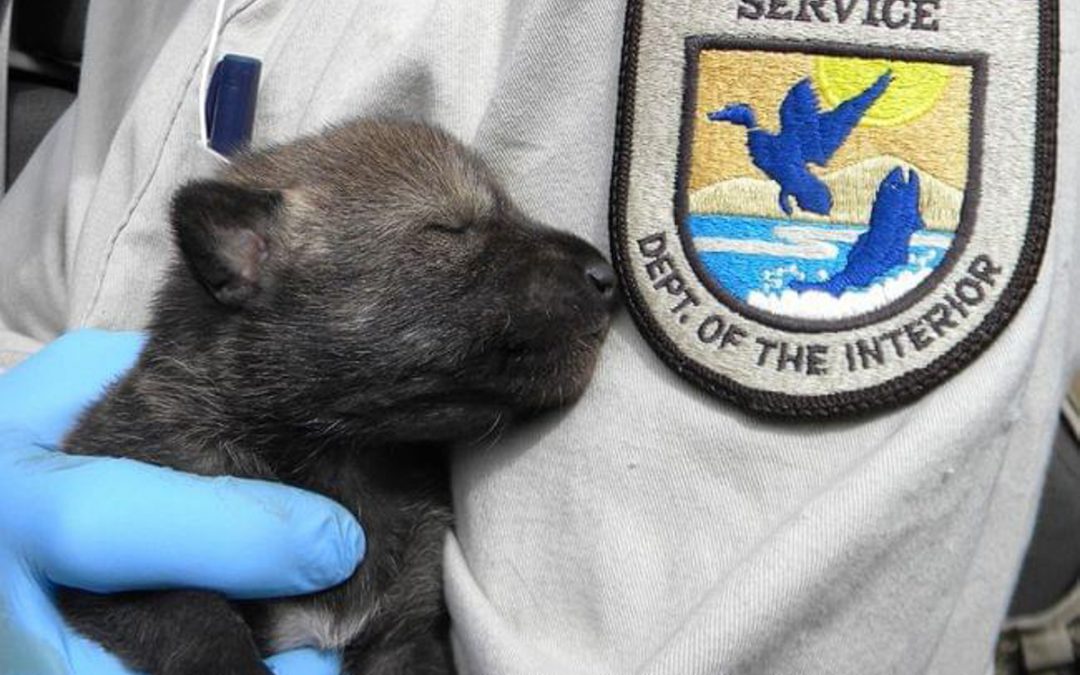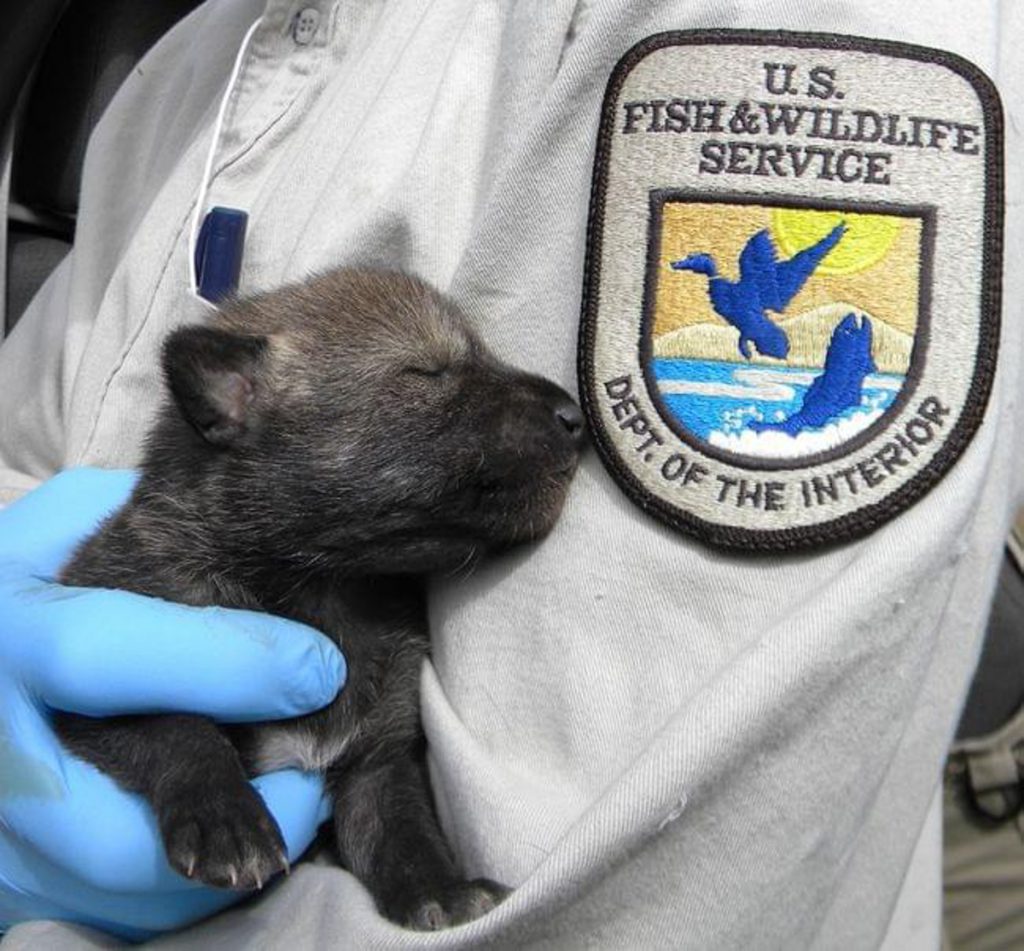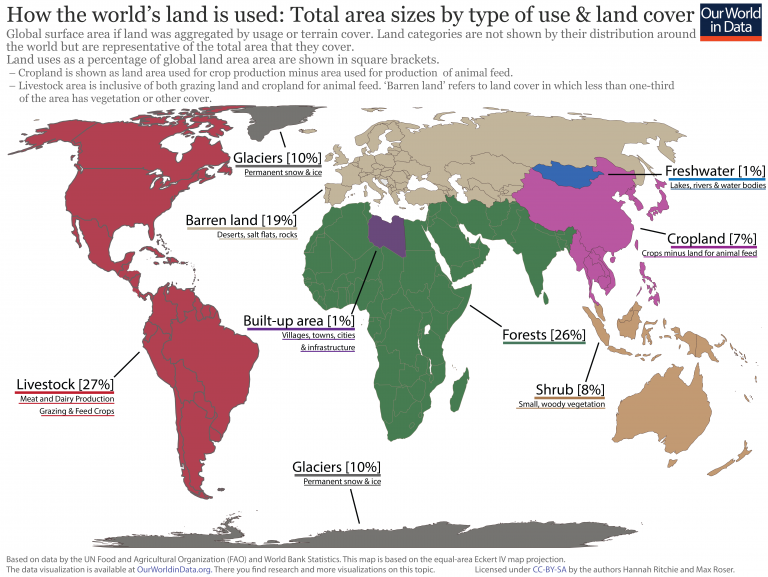
by Lee H. | Jul 16, 2022 | Climate Action Committee

Red wolf communities once populated the continent, from Texas and Oklahoma and Kansas in the west, to Pennsylvania and New Jersey in the east. Were they still here, they’d be naturally curbing the population of white-tailed deer. They are completely gone from our state, chased off by hunting and agribusiness.
Our age has been coined the Anthropocene. We have gone so far as to alter the climate that protects all living beings on Earth.
To make room for grazing, we buried huge swathes of prairie and forestlands. Why have we felt so free to blanket the great North American plains with chemically dependent monoculture crops and feedlots? Only because the interests of the wolves and coyotes, ferrets and foxes, cranes, owls and curlews posed no obstacles in our moral framework.
Today, are we different? No; we continue to displace indigenous beings for agribusiness interests.
Over the most recent three years, taxpayers have funded Wildlife Services killings of 188,670 coyotes, 74,630 beavers, 8,183 foxes, 2,108 bobcats, 1,267 black bears, 1,007 gray wolves, 784 cougars, and 12 endangered grizzly bears.
So this is another reason to divest from animal agribusiness. Not only is it a massive emitter of methane and a heavily carbon-driven food system, but it’s killing the free-living animals. Wolf kills are going on now – in Idaho, Utah, Colorado, Montana, Washington, Oregon, and Wyoming – as wolves are reviled for eating into the profits of sheep farming.
Same story for the grass-fed beef cattle. Wolves and coyotes, free-roaming horses and burros, and many other untamed animals are targeted because ranchers don’t want them there. While grass-fed is promoted as an environmental benefit, in reality, all cattle are grass-fed. They start on pastures, then wind up at feedlots and are eventually trucked to slaughter.
Organic, biodynamic, regenerative, and now targeted grazing have been praised as the answer to soil health. On the African continent, cattle farming is being rebranded as sustainable. But all are systems in which massive amounts of water and feed are diverted to animals who are bred into existence only to be used and slaughtered. We do not have the water, forage, feed or grass to sustain this business. And cattle grazing is leading the threats to biodiversity.
Meanwhile, dairy cows are kept in intensive confinement and machine-milked. Dairy farmers are now using water sprayers and air conditioners (more electricity!) because milk production wanes as summer temperatures rise.
Intensive confinement for any animals becomes like a petri dish for diseases and viruses. Recently, bird flu has apparently jumped from intensive commercial bird farms to the Harbour seals of Quebec. For struggling species, there is a lot of collateral damage from animal agribusiness
Loops Upon Loops
Agribusiness, mostly grazing and feed production, is the key driver of deforestation. And then, human-driven climate disruption itself degrades still more forests. And degraded forests have a hard time absorbing CO2. Thus, more global heating.
We know the heating of this continent is causing strange disasters that take tolls on human lives. Are we paying attention to what it’s doing to the rest of the planet’s living communities?
Bark beetles thrive unnaturally in a warming West. They are free to eat up the pine bark, thwarting the growth of pine seeds that serve as food for endangered bears of the Yellowstone.
This is an example of the links between our food systems, climate, and extinctions. It’s somewhat hard to wrap our heads around these links, and it’s easy enough for most of us to pay no attention until climate crisis arrives at our own doorsteps. And yet, as with the famous effect of the butterflies flapping their wings, everything is connected. When any one ecosystem unravels, the entire biocommunity of a continent eventually suffers for it.
The best answers might not be easy, but they are simple.
We stop breeding cows into existence for consumer demand. We stop using land for feed crops for industrially confined, mechanized dairy animals.
Already, the livestock sector (meat and dairy production, grazing and feed crops) covers 27% of the Earth’s total land surface. That’s more than the Earth’s forested lands – which are rapidly being degraded and destroyed for animal agribusiness.

And if we divest ourselves from animal agribusiness, with its high carbon and methane emissions, its waste runoff, and its indifference to aware beings? This will help us shift to direct use of land to grow human food – as opposed to allocating it to the global feed markets that create economic dependencies and usurp far more planetary space than humanity needs.
And it will align our food system with the Quaker testimonies of simplicity and peace. Consider the radical approach to these testimonies taken by the well-known Quaker humanitarian Benjamin Lay. Preaching an anti-slavery message all the way from London to York in the north of England, Benjamin Lay walked. Why? Lay was protesting the oppression of both the stablehands and the horses. Lay refused to subjugate others in the human community – and beyond. Benjamin Lay would find plenty to protest today.
Lee H., Radnor Friends Climate Action Committee
_____
Banner photo of red wolf pup: public domain (FWS.gov).

by Lee H. | Mar 25, 2022 | Climate Action Committee
 Enjoy cooking? Eat “low on the food chain” and decrease emissions, land use, global deforestation and habitat loss.
Enjoy cooking? Eat “low on the food chain” and decrease emissions, land use, global deforestation and habitat loss.
On the level of personal impact, divestment from animal products has more climate-preserving power than divestment from fossil fuels. Planning a plant-based potluck or fellowship hour is as vital as reducing our annual mileage or easing our heating requirements. And we can enjoy every bite of the commitment! Here are a few recipes for friendship and gathering. Those without a specific credit are adapted from Dining With Friends: The Art of North American Vegan Cuisine (P. Feral & L. Hall, Nectar Bat Press, 2010).
Tapenade and Radishes on Baguette
This friendly hors d’oeuvre recipe was created by Mark Basile. The plate may be assembled a few hours ahead of time, and kept in the refrigerator until you are ready to serve.
Ingredients
1 baguette, cut into half-inch diagonal slices
2 bunches fresh radishes, thinly sliced
3/4 cup of pitted Kalamata olives
¼ cup of green, pitted Greek olives
Squeeze of fresh lemon juice
Fresh chives, snipped with scissors into pieces an eighth of an inch long
Salt and ground pepper
Place all olives into a food processor and mix into a rich paste. Add a squeeze of lemon juice. Cut baguette slices in ovals, 2 to 3 inches long. Spread a thin layer of tapenade on bread pieces.
Thinly slice the radishes. Place them on top of the tapenade and press lightly to hold in place. Sprinkle with a little salt and pepper, and top with a sprinkle of snipped chives. Serve chilled.
Black Bean Soup
This high-protein dish serves 12.
Ingredients
2 tablespoons extra virgin olive oil
3 cups diced carrot
2 cups diced onion
2 cups diced celery
1 tablespoon each of minced garlic, oregano, basil, salt, and pepper.
10 cups vegetable broth
1 can diced tomato
1 tablespoon tamari or low-sodium soy sauce
6 cups cooked black beans
½ cup chopped parsley
Heat oil in an extra-large soup pot. Sauté the diced vegetables lightly, then add everything but the parsley. Simmer for 30 minutes and then add the parsley and additional salt and pepper if desired.
Yellow Split Pea Soup
Made with mild yellow split peas, this dish serves 12.
Ingredients 2 to 3 tablespoons olive oil
1 onion, diced
6 stalks each of celery and carrots, diced
3 cups washed, dried yellow split peas
3 potatoes, chopped in bite-sized chunks.
12 cups vegetable broth
2 teaspoons curry powder; 1 bay leaf; 2 teaspoons thyme; ground pepper; salt.
Sauté onion, celery and carrots in olive oil for several minutes in soup pot. Add the dry split peas, vegetable broth, curry powder, bay leaf, thyme, potato, salt, and pepper. Simmer over medium-low heat for one hour, or longer until the peas are soft.
Lentil Soup
The lentil is second only to the soybean in protein content, and can be grown by small farmers all over the world, including very dry areas. It’s the perfect food. This soup serves 8.
Ingredients
3 cups dry lentils, rinsed
12 cups salted cold water
4 cups each: large, chopped carrots and celery
medium, chopped onion
2 tablespoons olive oil
3-4 cups canned tomatoes
Cook lentils in water for 45 minutes, partially covered. Add vegetables and oil. Simmer for 30 minutes. Stir often. Salt and pepper to taste.
Chickpea Curry in a Hurry
This one comes courtesy of LouAnne McDonald, a Friend in Connecticut. It is adapted from a Lorna Sass recipe.
1 cup brown or brown basmati rice
2 cans (14.5 oz) diced tomatoes with green chiles;
2 cans (15 oz) garbanzo beans, drained and rinsed well in colander
2 tablespoons minced garlic
4 teaspoons curry powder
2/3 cup unsweetened, dried grated coconut
16 oz baby spinach
Start cooking the rice ahead of time—it takes a lot longer than the rest of the recipe. The amount of water added should be double the amount of rice. We use a stainless steel rice cooker.
In a large saucepan, combine the next five ingredients. Bring to a boil over high heat, then lower the heat and add the spinach in batches. At first it will seem like too much spinach, but the spinach shrinks down as it cooks. (Throw the spinach in straight from the bag; it doesn’t need to be chopped.) Cover and cook over medium heat about 10 minutes. Stir occasionally. Serve the curry over the rice. (For potlucks, you might add the cooked rice to the curry and stir well.)
Makes 6-8 servings.
And now, from Margy…
Tofu Cubes
These are so delicious and versatile, able to accompany salads or other dishes with flair.
Press an extra-firm block of tofu for a half-hour to a couple of hours.
Don’t have a tofu press? Don’t worry; now is the moment to celebrate simplicty! Just grab a clean kitchen towel and a heavy skillet or cutting board with a heavy can on top for weight. Wrap the tofu block in the towel, to absorb liquid from the tofu. Put your wrapped tofu on a baking sheet, and the weight on your wrapped tofu.
Cut the pressed tofu into about ½” cubes and coat them with olive oil.
Then sprinkle them with garlic powder, onion powder, salt and pepper.
Next, sprinkle the cubes with corn starch and bake at 400F for 15 minutes. Turn over; bake ~10 more minutes.
Enjoy!!
Bidi’s Hearty Italian Bean Soup (Variation on Italian Pasta e Fagioli)
This is already a popular dish at Fellowship lunches. Thanks to Bidi McSorley, who says: “Enjoy. It always is a hit and so simple!”
Ingredients
1 medium onion
3 to 5 cloves of garlic
Basil, fresh or dried
A can each of cannellini beans and diced tomatoes
Veggie broth
Dry quinoa as desired (Bidi uses a quarter cup)
Two to 3 handfuls of baby spinach or baby kale
Preparation
Sauté the onions in olive oil for about 10 minutes (low heat)
Mince or garlic press the garlic and add to the onions. Add a few shakes of dried basil, about a ¼ teaspoon. If you’re using fresh basil, you’ll add this later instead
Sauté 5 more minutes.
Once the onions are clear, add the can of cannellini beans (including the liquid and soft residue from the can) and the can of diced tomatoes, including the liquid.
Add lots of salt and pepper.
Add the veggie broth, probably about 3 to 4 cups or one box.
Let all of this simmer for about 30 minutes or more.
About 20 minutes before you’re going to serve it, add the quinoa. Then, 10 minutes later, add the handfuls of the greens. If you’re using fresh basil, add 2 to 3 tablespoons finally chopped.
Let everything sit for another 10 minutes and then serve!
Notes
I often serve it with shredded Parmesan to put on top.
Yes, major grocery stores do have plant-based parmesan wedges, made by a company called Violife, usually available where they stock the tofu and such. They are very good; try them!
And, of course, recheck the salt and pepper and add more if needed. That’s it – a very simple soup. For the fellowship lunch, I added a can of small red beans instead of cannellini because that’s what I had! If you are a purist and soak your own beans, more power to you. You probably still want to add a little bit of liquid from the soaking because it has the starch in it that helps thicken the soup. Bigger crowd? Double or triple ingredients. For fellowship lunch, I use three cans of beans and go from there.
Roasted Cauliflower Soup
Bidi McSorley says: “Burt makes a variation of this and adds lemon zest which is very good.”
Ingredients
1 large head cauliflower (about 2 pounds), cut into bite-size florets 3 tablespoons extra-virgin olive oil, divided Fine sea salt 1 medium red onion, chopped 2 cloves garlic, pressed or minced 3 cups (32 ounces) vegetable broth 1 can coconut milk
¼ cup cashews, soaked for 4 hours, then drain and rinse them (if you have a high-powered blender like a Vitamix or Blendtec, you can skip this).
1 tablespoon fresh lemon juice, or more if needed Scant ¼ teaspoon ground nutmeg For garnish: 2 tablespoons finely chopped fresh flat-leaf parsley, chives and/or green onions
Preparation
Preheat the oven to 425 degrees Fahrenheit. If desired, line a large, rimmed baking sheet with parchment paper for easy cleanup. On the baking sheet, toss the cauliflower with 2 tablespoons of the olive oil until lightly and evenly coated in oil. Arrange the cauliflower in a single layer and sprinkle lightly with salt. Bake until the cauliflower is tender and caramelized on the edges, 25 to 35 minutes, tossing halfway. Once the cauliflower is almost done, in a Dutch oven or soup pot, warm the remaining 1 tablespoon olive oil over medium heat until shimmering. Add the onion and ¼ teaspoon salt. Cook, stirring occasionally, until the onion is softened and turning translucent, 5 to 7 minutes. Add the garlic and cook, stirring constantly, until fragrant, about 30 seconds, then add the broth and the coconut milk.. Reserve 4 of the prettiest roasted cauliflower florets for garnish. Then transfer the remaining cauliflower to the pot. Increase the heat to medium-high and bring the mixture to a simmer, then reduce the heat as necessary to maintain a gentle simmer. Cook, stirring occasionally, for 20 minutes, to give the flavors time to meld. Once the soup is done cooking, remove the pot from the heat and let it cool for a few minutes. Then, carefully transfer the hot soup to a blender, working in batches if necessary. (Do not fill past the maximum fill line or the soup could overflow!) Add the cashews and blend until smooth. Add the lemon juice and nutmeg and blend again. May need 1 to 2 cups of additional broth . Add additional salt, to taste (I usually add another ¼ to ¾ teaspoon, depending on the broth). This soup tastes amazing once it’s properly salted! You can also a little more lemon juice, if it needs more zing. Blend again. Top individual bowls of soup with 1 roasted cauliflower floret and a sprinkle of chopped parsley, green onion and/or chives. This soup keeps well in the refrigerator, covered, for about four days, or for several months in the freezer.
Now, from Ina, here’s…
Alla’s Borshch (Borscht)
Ingredients:
- 1 can drained white kidney or cannellini beans
- 4 medium-sized, scrubbed beetroots (beets), with tops and bottoms trimmed off
- 3 large, whole carrots, diced into ½-inch cubes
- 1 cup green beans, cut into ½-inch pieces
- 3 large celery ribs, diced into ¼-inch cubes
- 1 diced, medium-sized parsnip
- 2 diced, large yellow onions
- 6 cloves garlic fine dice or crush
- 3 large bay leaves
- 1/8 tsp dried cloves
- 4 medium potatoes 1/2“ dice
- 1/4 Lg cabbage head fine chopped or grated like slaw
- 1 tbsp lemon juice (or vinegar)
- 1/2 Tbs of sugar
- 1 sm can tomato paste
- 1 large can tomato San Marzano or Italian tomatoes crushed
- sunflower oil (for frying)
- black peppercorns – to taste and pinch of pepper flake
- salt – to taste or better still vegetable or chicken bouillon seasoning
- 1 small handful of dried porcini, soak and save liquid. Chop reconstituted mushrooms finely and add to soup along with liquid. (A secret ingredient)
Add enough water to cover all the vegetables once combined and check on how thick it is during cooking so you have adequate broth to vegetable ratio.
Serving
- 1 heaping tablespoon of vegan sour cream (see below) per bowl
- a couple of rustic bread slices
- fresh parsley – to taste
- spring onion – to taste
- fresh dill – to taste
Preparation:
Of the 4 beetroots 1 chopped into the soup. Set aside 3 and boil until tender in lightly salted water that just covers them.
Peel and wash all vegetables Chop 1 of beetroots (medium dice), onion, garlic and potatoes into bite size pcs. Grate carrots or cut into ¼-inc cubes; shred or cut cabbage finely. Sauté in a few tablespoon sunflower oil.
Add tomato paste, sugar, and lemon juice (aiming for a balanced sweet-sour taste). For more sour adjust using red balsamic vinegar.
Add all the ingredients; veg. , spices and water and bring to a boil. Then lower heat to a medium simmer for 30-40 minutes.
Take one or two of the boiled beets and grate into the borshch. Also add the red liquid from boiling the beets about a cup. This gives it its beautiful color and taste. Adjust sweet/sour ratio to taste carefully with lemon juice or balsamic vinegar
Although borshch appears on Russian and Polish menus as well, its recipe is rooted in Ukraine.
[ADD ANIMAL-FREE SOUR CREAM RECIPE]
Chocolate Layer Cake
This delightful dessert also comes courtesy of LouAnne McDonald. It is based on a recipe from Health Coach Mary Lawrence, founder of Well on Wheels, LLC.
Dry Ingredients:
2 cups whole wheat pastry flour
¾ cup unsweetened cocoa powder
¼ cup vegan sugar (all organic sugar is vegan) or Sucanat
1 tablespoon baking powder
2 tsp baking soda
1 teaspoon sea salt
1 teaspoon cinnamon
Also need plastic wrap.
Liquid Ingredients:
1 cup vanilla soy milk
1 cup water
¼ cup canola oil
6 tablespoons (3/8 cup) raspberry seedless all-fruit jam
¾ cup maple syrup
2 tablespoons vanilla extract
2 teaspoons almond extract
2 tablespoons apple cider vinegar
Icing:
2 cups firm silken tofu (1 1/3 pkg)
2 tablespoons whole wheat pastry flour
6 tablespoons maple syrup (3/8 cup)
1 teaspoon vanilla
2 cups vegan semi-sweet chocolate chips (one 12 oz bag)
5/8 cup raspberry seedless all-fruit jam
Raspberries for garnish (or slivered almonds)
Preheat oven to 350 F. Oil and lightly flour two 9-inch round cake pans. Sift flour, cocoa powder, sugar, baking powder, baking soda, salt and cinnamon in large bowl. In a blender, pour soy milk, water, canola oil, jam, maple syrup, vanilla and almond extracts, and vinegar. Blend on high speed for 1 minute, until smooth. Add liquid ingredients to dry ingredients and whisk until smooth. Pour batter into prepared cake pans a bake 20-25 minutes. The sides of the cake will pull away from the pan and the surface will spring back when pressed lightly. Cool cake in pan for 10 minutes. Then turn out cake onto a wire rack and cool. Wrap cake in plastic wrap and freeze 30 minutes.
For the icing: In a blender, mix tofu, flour, maple syrup and vanilla; if you have a Vitamix or other powerful blender, don’t overdo it! Transfer mixture to saucepan and add chocolate chips. Warm over very low heat (“simmer”), stirring often until chips have melted and blended completely. Refrigerate for several hours. To assemble: spread each top with a thin layer of raspberry jam. Frost the cake with the icing, and garnish with raspberries piled in the center.
Warm & Welcoming Apple Sauce Cake
This is easy to make and comes out great every time.
Ingredients
½ cup safflower oil
1 cup organic sugar
2 cups flour
½ teaspoon salt
½ teaspoon cloves
1 teaspoon cinnamon
½ teaspoon nutmeg
1 teaspoon baking soda
1 cup raisins
1 cup hot apple sauce without sugar
A handful of chopped walnuts or pecans (optional)
Mix the oil and sugar. Combine the spices and raisins with flour and spoon this into the oil/sugar mix, alternating with hot applesauce. Cream until smooth.
Pour into greased and floured 6-by-10-inch pan. Bake at 350 F for 45 minutes.
Shopping at Giant Food?
First, the fellowship staples…
Coffees, Teas, Creamers, Sweeteners, and Butters
Most any fair-trade coffee or tea is vegan-friendly as well as socially responsible. Good coffee creamers that blend smoothly into your coffee are available. Check the (non)dairy case at Giant. Examples are Califia Farms Almond Milk Creamer Vanilla and Silk Oat Yeah, in vanilla or oatmeal cookie style. (You’ve likely heard about the severe water shortage in California. Oat may be preferred to almonds in terms of water use.)
For best blending with coffee, pick a plant-based creamer rather than a plant-based beverage or milk. Plant “milks” and nut “beverages” are great—but intended for breakfast cereal and to use as milk for baking.
A good, pollinator-friendly replacement for honey is stevia or agave nectar. Either is great for coffee or tea. Organic sugar is also vegan.
Need some good vegan butter for the table? Giant has some nice ones. Try Miyoko’s Cultured Vegan Butter. It’s a gourmet offering made by a small but renowned woman-owned company in California. It’s preservative-free and perishable, so refrigerate promptly after the gathering.
Vegan Crackers and Cookies at Giant
Nature’s Promise Organic Clubhouse Crackers are vegan. Giant’s Clubhouse Crackers are vegan. Mary’s Gone Crackers is a popular vegan brand. Most rice crackers and some of the wovenwheat, organic, or grain-free styles are vegan. Usually they will say “vegan” somewhere on the package. Look out for butter, cheese, milk, or whey in the ingredients list. Those are all dairy (not plant-based) ingredients.
Partake Foods is allergen-free and one of today’s rising Black-owned business. The company has cookies in many grocery stores now.
What About Cheese?
Ask a staffer to point to the vegan cheese aisle. At Giant, a good sliced vegan cheese is Chao, by Field Roast. Great for finger sandwiches or cut into squares for crackers. Violife is also very good. There are many other kinds, but these two are standouts for taste and consistency.
Giant’s Vegan Recipes
Check out Giant Foods’ All About Eating Vegan page. It has a nice summary of why people eat vegan, and includes several attractive, illustrated recipes:
RECIPE: Pumpkin-Lentil Stew • RECIPE: Kale-Quinoa Salad with Edamame • RECIPE: Spicy Air Fryer Crispy Tofu Bowl • RECIPE: Vegan Chocolate Tart • RECIPE: Spanish-Style Stewed Spinach and Chickpeas
How Are Eggs Replaced in Recipes?
If you have a recipe that calls for eggs, the easiest substitute is Ener-G Egg Replacer. Walmart has it. The directions are easy (mix with water). You can keep it in your cupboard or your fridge for many months. It’s basically just a tapioca flour.
If you prefer to shop at Target, look for Bob’s Red Mill Egg Replacer, in-store or online. For just 4 dollars, you get the equivalent of 34 eggs for baking. Bob’s Red Mill is an employee-owned company. (Giant’s liquid “egg substitute” is made of eggs, so it’s not vegan.)
Eggs really have a big carbon impact, as chicken operations are tied into the global feed market, which is transportation-intensive, and uses extensive land, not to mention water—all for feed crops rather than direct human food. These factors make animal agribusiness energy-costly and emissions-heavy, even when the animals involved are not ruminants.
Fair Trade + Vegan: Making the Connections
Mindful shopping helps support producers who care about poverty alleviation, gender equity, rights of children, and worker safety. Fair trade matters—especially when shopping for cocoa and chocolate, coffee, and tea. Vegan offerings bring the interests of other conscious beings into the picture. As we seek to protect the environment, we’re mindful of the animals who inhabit it. As we question the use of harmful chemicals, we address the emissions of methane, waste runoff, and other dangerous effects of animal agribusiness. Vegan offerings complement mindful fair-trade standards.
Bon Appétit!
You might also be interested in… how electric cars fit in with a personal commitment to Earth care.
_____
Photo credit: Fuzzy Rescue, via Pexels.





